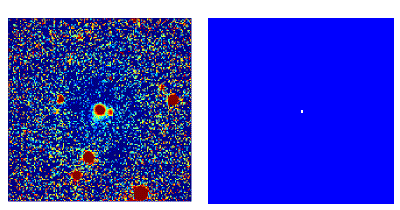Comet 9P/Tempel 1
Deep Impact Ejecta Plume Animation and Model
2005 July 4.3, 5.2, 6.2, 7.2, 8.2, 9.2, 10.2 UT
LEFT: Daily sequence begins 50 minutes following the impact.
Each image has been differenced to frames obtained just prior
to impact, and has had a radial 1/rho profile removed,
to enhance the ejecta plume released by the projectile.
The main ejecta plume, appearing as an arc, moves outward towards the right
day by day, slowing and dispersing with time, and that the plume forms
its own dust "tail" in the lower-right quadrant which is rapidly swept
back towards the lower-left due to radiation pressure from the Sun.
RIGHT: Synthetic Monte Carlo model of the ejecta plume.
The opening angle of the ejecta cone from the impact crater
is about 70deg in width and the center of the cone
(seen nearly side-on) points to a position angle of 255deg
(15deg South of West) and is 20deg this side of the plane of the sky.
The maximum dust velocity was ~0.23 km/s and the dust grains
are between about 0.5 and 2.5 microns in diameter.
Images obtained by Kate Barnes and Nicole Baugh
using the Hall 42-inch (1.1-m) telescope at Lowell Observatory
with a broadband R filter, dominated by dust grains.
North is at the top, East is to the left.
The Sun has a position angle of 290 degrees.
Trimmed image size: ~190"x190" or 120,000x120,000 km.
Image processing and animation sequence by Barnes, Baugh, and David Schleicher.
Monte Carlo modeling by David Schleicher.
Copyright 2005 Lowell Observatory

